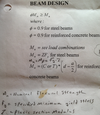Mechanics & Structures Basic Equations Flashcards
(30 cards)
Provide Equation for Stress for an Axial Loaded Member
axial stress is equal to the axial force divided by the cross setional area

Provide Equation for Strain for an Axial Loaded Member
Axial Strain (Epsilon) is equal to the elongation (delta) divided by the origional length

Provide Equation for Modulas of Elasticity (Hooks Law) for an Axial Loaded Member
Modulas of Elastcity (Youngs Modulas) is equal to the axial stress divided by the axial strain

Provide Equation for Elongation for an Axial Loaded Member
The elongation of an axial loaded memer is the summation of all applied loads times the lengths of the members divided by the cross sectional area time the modulas of elasticy of the members.

Provide Equation for Poison’s Ratio for an Axial Loaded Member
Poson’s Ratio is the laterial strain divided by the axial strain. The lateral strain is negative becasue al the member is elongated, the cross section area become decreased. This is proportional for a linear elastic member (a memeber in the Hook’s Law Portion.

Provide equation for elongation due to temperature change in an Axial Loaded Member
Elongation is equal to the coefficient of thermal expansion time the change in temperature time the origional length of the member

Provide equation for Torsional Shear Stress for Torsion/Power Design?
Torsional Shear stress from the Torsion Law is eqaul to the appltied Torque time the radius where the shear will be measured divided by the polar moment of Inertia.

Provide equation for Angle of Twist for Torsion/Power Design?
The angle of twist for a member in torsion is equyal to the Torque applied to the member time the orional length of the member divided by the shear modular of elasticity time the polar moment of inertia.

Provide equation for Power for Torsion/Power Design?
Power is equal to Torque times the angular Velocity

Provide equation for Angular Velocity for Torsion/Power Design?
Angular Velocity is equal to 2 times pi times the frequency

Provide equation for Torsional Shear Strain for Torsion/Power Design?
Torsional Shear Strain is equal to the radius where the strain will be measured time the angle of twist divided by the origional length of the member

Provide equation for Shear Modulas of Elasticity for Torsion/Power Design?
Shear Modulas of Elasticity is equal to the shear stress divided by the shear strain

1 horsepower= ____ ft-lb/s?
1 horsepower is equal to 550 ft-lb/s?

Polar Moment of Inertia for a circle
Polar Moment of Inertia for a circle is equal to pi time the radius raised to the 4th power divided by 2 of pi time the diameter raised to the 4th power divided by 32

Moment of Inertia for a circle
The moment of inertia for a circle is equal to pi time the radius raised to the 4th power divided by 4 or pi times the diameter raised to the 4th power divided by 64

Moment of Inertia for a rectangle
The moment of inertia for a rectangle is equal to the base time the height raised to the 3rd power divided by 12

What is the equation for the Parallel Axis Theorem & what is it used for
The equation for the parallel axis theorem is the summation of the moment of inertia plus the area times the distance from the area of concern to the centroid of all members squared
The Parallel axis theorem is used for finding the moment of Inertia.

Provide Equation for Bending Stress for a Beam
The bending stress for a beam is equal to the moment time the centroid of the beam divided by the moment of inertia. Since section modula is equiviant to the moment of inertia divided the the centroid the equation for the bending srress for a beam becomes the moment divided by the section modulas of the member.

Provide Equation for Shear in a rectangular Beam, and explain what Q means
Shear in a rectangular beam is equal to the shear srtress time the summation (Ay) of the area above the plane of interest divided by the moment of inertia times the base width

Blank
Explain the equations for Basic Column Design for Compression members with Compact & Noncompact sections
φPn ≥ Pu Pn=Nominal Compressive Strength Pn=Fcr*Ag = Limit state of Flexural Buckling Fcr= Flexural Buckling Stress Fe= Elastic Critical Buckling Stress r= Governing Radius of Gyration K= Effective Length Factor φ= 0.9 for LRFD (Safety Factor)

Provide Equations for Steel and Reinforced Concrete Beam Design
Refer to Image

What is the area and where is the centroid for a rectangle, Triangle, Parabolic spandrel, and cubic spandrel?
Refer to Image

What are the 3 basic load combinations for design.
Refer to Image









